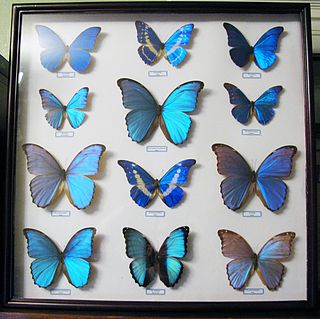
The morpho butterflies comprise many species of Neotropical butterfly under the genus Morpho. This genus includes more than 29 accepted species and 147 accepted subspecies, found mostly in South America, Mexico, and Central America. Morpho wingspans range from 7.5 cm (3.0 in) for M. rhodopteron to 20 cm (7.9 in) for M. hecuba, the imposing sunset morpho. The name morpho, meaning "changed" or "modified", is also an epithet. Blue morphos are severely threatened by the deforestation of tropical forests and habitat fragmentation. Humans provide a direct threat to this spectacular creature because their beauty attracts artists and collectors from all over the globe who wish to capture and display them. Aside from humans, birds like the jacamar and flycatcher are the adult butterfly’s natural predators.

The superfamily Papilionoidea contains all the butterflies except for the moth-like Hedyloidea.

The Menelaus blue morpho is one of thirty species of butterfly in the subfamily Morphinae. Its wingspan is approximately 12 cm (4.7"), and its dorsal forewings and hindwings are a bright, iridescent blue edged with black, while the ventral surfaces are brown. Its iridescent wings are an area of interest in research because of their unique microstructure. Due to its characteristic blue color, Morpho menelaus is considered valuable among collectors and was widely hunted in the 20th century.

Riodinidae is the family of metalmark butterflies. The common name "metalmarks" refers to the small, metallic-looking spots commonly found on their wings. The 1,532 species are placed in 146 genera. Although mostly Neotropical in distribution, the family is also represented both in the Nearctic, Palearctic, Australasian (Dicallaneura), Afrotropic, and Indomalayan realms.

The owl butterflies are species of the genus Caligo and are known for their huge eyespots, which resemble owls' eyes. They are found in the rainforests and secondary forests of Mexico, Central and South America.

The Satyrini is one of the tribes of the subfamily Satyrinae. It includes about 2200 species and is therefore the largest tribe in the subfamily which comprises 2500 species.

The Morphinae are a subfamily of Nymphalidae butterflies that includes the morphos, the owl butterflies (Caligo), and related lineages. It is either considered a sister group of the Satyrinae, or disassembled and included therein.

The Haeterini are one of the smaller tribes of the Satyrinae in the Nymphalidae family. The tribe occurs exclusively in tropical rain forests in the Neotropical realm.

The Elymniini is one of the tribes of the subfamily Satyrinae. If the subfamily Satyrinae elevate to family status, this tribe shall be treated as subfamily Elymniinae. Elymniini was formerly a large group, but recently, it is considered to be include only one genus, Elymnias, according to molecular phylogenetic analyses.

The butterfly subtribe Euptychiina is a diverse group within the tribe Satyrini, occurring throughout Central and South America, in addition to a few species known from North America. Euptychiina is a predominantly lowland group, with the exception of one Asian taxon Palaeonympha opalinaButler, 1871 and the Andean genus ForsterinariaGray, 1973. The taxon was erected by Lee Denmar Miller.

Brassolini is a tribe usually placed in the brush-footed butterfly subfamily Morphinae, which is often included in the Satyrinae as a tribe Morphini. If this is accepted, the Brassolini become the sister tribe of the Morphini among the Satyrinae. Formerly, they were treated as an independent family Brassolidae or subfamily Brassolinae. Many members of this tribe are called owl butterflies.

Cithaerias is a Neotropical butterfly genus from the subfamily Satyrinae in the family Nymphalidae.

Cithaerias andromeda, the Andromeda satyr, is a species of butterfly of the family Nymphalidae. It is found from Suriname, French Guiana, Venezuela, Peru, Bolivia and Brazil. Differentiation between subspecies and their corresponding sex is possible through variation in wing pattern as well as genitalia. The presence of brown bands in the hind wings of C. andromeda and a corpus bursae are common features in these female butterflies.

Pronophilina is a Neotropical subtribe of butterflies of the subfamily Satyrinae. They are a species-rich group with highest diversity in the tropical and subtropical mountains, especially the Andes. Before 1970, they were poorly studied, but recent interest has resulted in high rates of species description from previously unexplored mountain ranges. However, there is still a lack of knowledge on their biology and ecology. Their relationship to other groups of Satyrine butterflies and their complex patterns of speciation within and among mountain ranges have led to several biogeographic discussions.
Taygetina peribaea is a species of butterfly in the subfamily Satyrinae. It is found in the Neotropical realm.
Guaianaza is a monotypic butterfly genus of the subfamily Satyrinae in the family Nymphalidae. Guaianaza is considered a synonym of the genus Forsterinaria Gray, 1973. Its single species, Guaianaza pronophila, is found in the Neotropical realm.
Taygetina is a monotypic butterfly genus of the subfamily Satyrinae in the family Nymphalidae. The species in Coeruleotaygetis have been included in Taygetina. Its one species, Taygetina banghaasi, is found in the Neotropical realm.

Argyrophorus is a butterfly genus from the subfamily Satyrinae in the family Nymphalidae. It is distributed between Chile, Argentina and Perú. The systematic and circumscription of the genus is disputed.

Hyantis is a monotypic nymphalid butterfly genus. Its sole species is Hyantis hodeva, which is found in New Guinea. It is uncertain which tribe this butterfly should be placed within.

Taguaiba fulginia is a species of butterfly of the family Nymphalidae. It is found in the southeastern Brazilian states of Minas Gerais, Rio de Janeiro and São Paulo at altitudes ranging from sea level to 250 metres (820 ft).
















